Key takeaways:
- The four phases of clinical trials are essential for assessing safety, efficacy, and long-term effects of treatments, each serving a distinct purpose in the research process.
- Clinical trials not only advance medical science but also involve real people, highlighting the ethical responsibility of researchers to ensure patient safety and well-being.
- Patient experiences and voices are increasingly influencing the design of trials, driving a more patient-centric approach to research.
- Transparency in trial data is crucial for fostering collaboration between researchers and patients, ultimately leading to more effective and compassionate research practices.
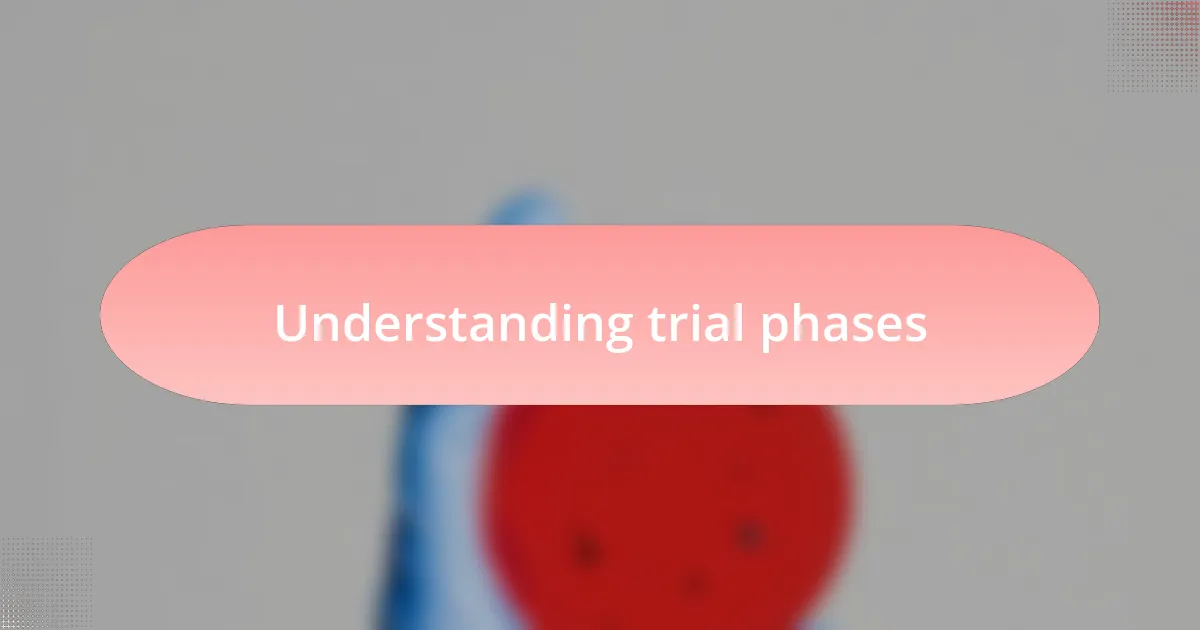
Understanding trial phases
When I first delved into trial phases, it struck me how essential they are in developing new treatments. Each phase serves a distinct purpose, like puzzle pieces that come together to ensure a medication’s safety and efficacy before it reaches patients. Have you ever wondered how something goes from a lab bench to your pharmacy shelf? Understanding these stages brings clarity to that process.
I recall a time when a friend participated in a clinical trial. It was fascinating to see her excitement, coupled with the understandable anxiety of the unknown. Trial phases are where hope meets rigorous science; they encompass everything from initial safety tests in Phase I to larger-scale efficacy trials in Phase III. It’s a delicate balance between optimism and caution that can truly capture the essence of medical research.
Through my exploration, I’ve come to appreciate that each phase not only tests a drug’s effectiveness but also focuses on real-world impacts. What if a treatment works well in a controlled environment but fails in everyday scenarios? This is why Phase IV, or post-marketing studies, are critical—they ensure the long-term safety of therapies in the wider population. Understanding trial phases is not just about the science; it’s about the lives that stand to be changed.
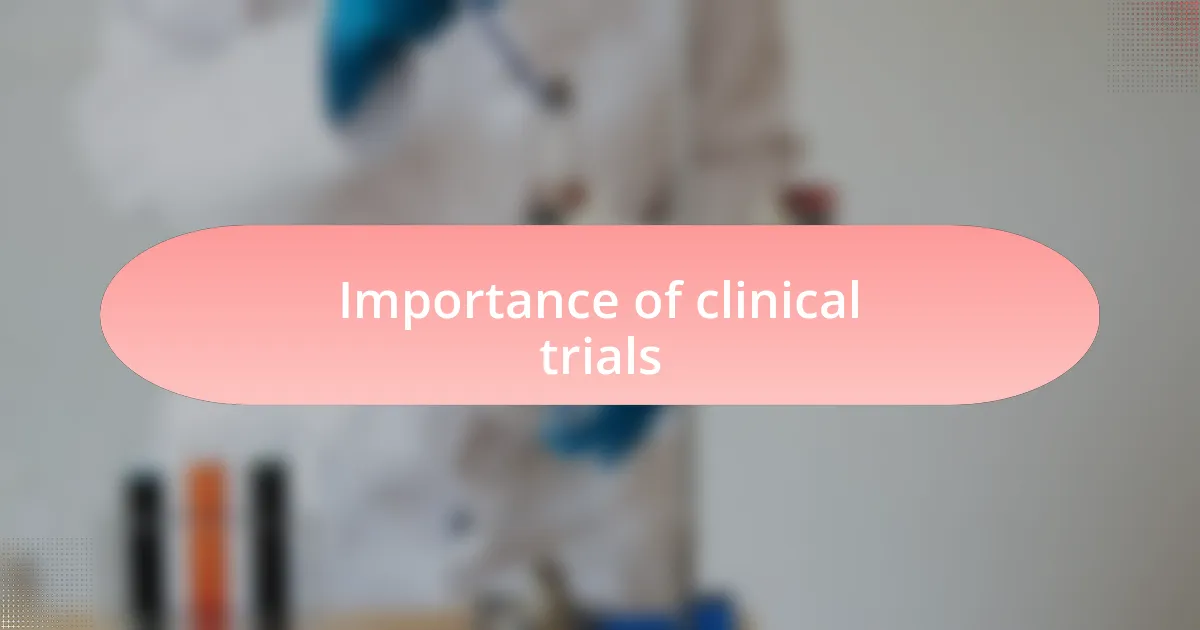
Importance of clinical trials
The importance of clinical trials cannot be overstated; they are the backbone of medical advancement. I’ve seen firsthand how these trials pave the way for breakthroughs in treatment options. Without them, innovations would remain mere theories, never making it to the patients who desperately need them. Isn’t it striking to think that a life-saving drug begins as a hypothesis, only to be refined through rigorous testing?
Consider the dedication involved in these trials. I remember attending a seminar where a researcher shared stories of patients who participate in trials, driven by the hope of alleviating their conditions. These narratives illustrate that clinical trials are not just about data; they involve real people with real hopes and fears. It’s a powerful reminder that each data point represents someone’s journey towards better health.
Moreover, trials play a crucial role in identifying potential side effects that may not be apparent in smaller studies. I often reflect on a discussion I had with a doctor who was involved in a Phase II trial. He emphasized the responsibility researchers have to ensure that new therapies do not just work but do so safely. Such insights reinforce my belief that clinical trials not only advance science but also uphold the ethical obligation to protect patients throughout the process.
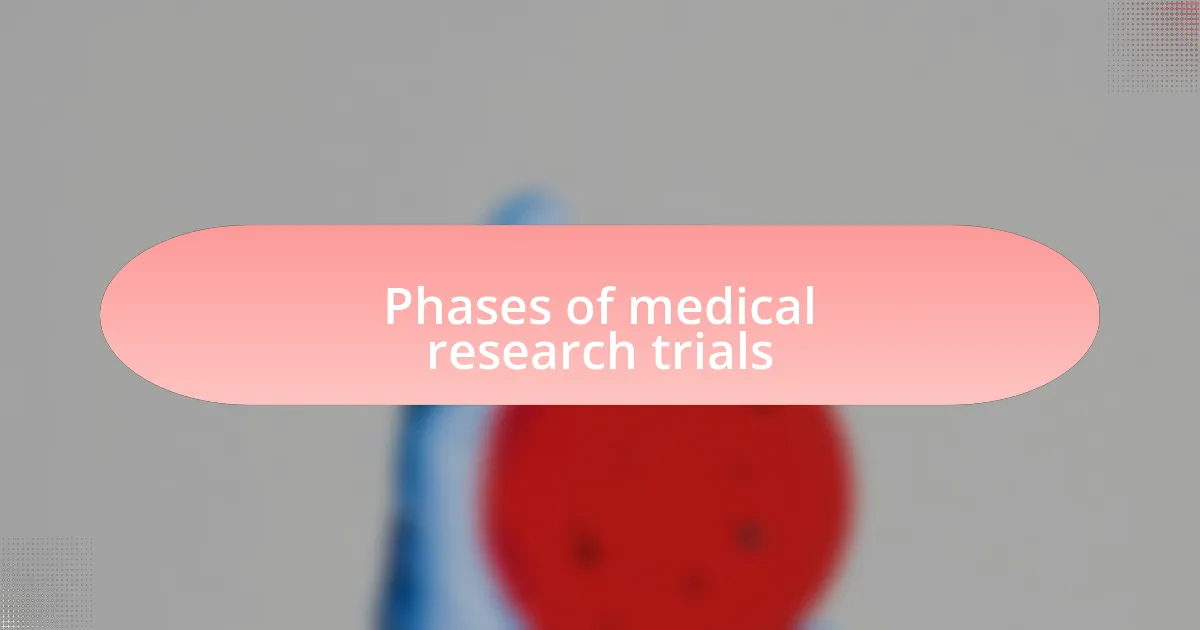
Phases of medical research trials
The journey of a medical research trial typically consists of four phases, each serving a distinct purpose. In my experience, Phase I is where it all begins, focusing on safety and dosage. I remember reading about a Phase I trial for a new cancer treatment, where researchers administered the drug to a small group of healthy volunteers. It’s fascinating to think how every volunteer plays a crucial role in determining if a treatment has the potential to help patients later on.
As trials progress to Phase II, the emphasis shifts to efficacy. I once attended a discussion where researchers shared their excitement when they started seeing positive responses in patients. The atmosphere was electric. Have you ever felt that surge of hope when witnessing something that could change lives? Phase II trials are where those glimmers of hope become more tangible, affirming that the treatment is not just safe but also effective in a larger group of affected individuals.
Phase III trials are often where the real magic happens. I recall an intriguing case study about a groundbreaking therapy that went through extensive Phase III testing, involving thousands of participants. The scale of these trials opens the door to insights that smaller studies simply can’t capture. It’s almost remarkable to imagine how many people contribute to the final approval of a treatment—each participant’s experience weaving together to create a data tapestry that can lead to life-saving therapies.

Key objectives of each phase
In Phase I, the key objective is primarily to assess safety and tolerability of the treatment. I remember a case where researchers closely monitored every reaction in volunteers, capturing a range of responses. Isn’t it remarkable how each small step taken in this phase paves the way for groundbreaking discoveries and potential life-saving treatments?
Once we move to Phase II, the focus shifts to evaluating the effectiveness of the treatment. During a seminar I attended, one researcher shared how they would tweak dosages based on patient responses, striving to find the sweet spot that maximizes benefit while minimizing side effects. When you think about it, isn’t this phase where hope truly starts to blossom? It’s a critical moment where theoretical potential turns into real-world application.
Then, we arrive at Phase III, where the goal is to confirm efficacy and monitor adverse effects in a larger population. I vividly recall a compelling discussion about the sheer scale of participation and data generated in these trials; it felt like we were on the brink of ushering in a new era of treatment options. Can you imagine being part of something that might redefine treatment standards? Each participant contributes invaluable insights that could illuminate the path to a breakthrough therapy.
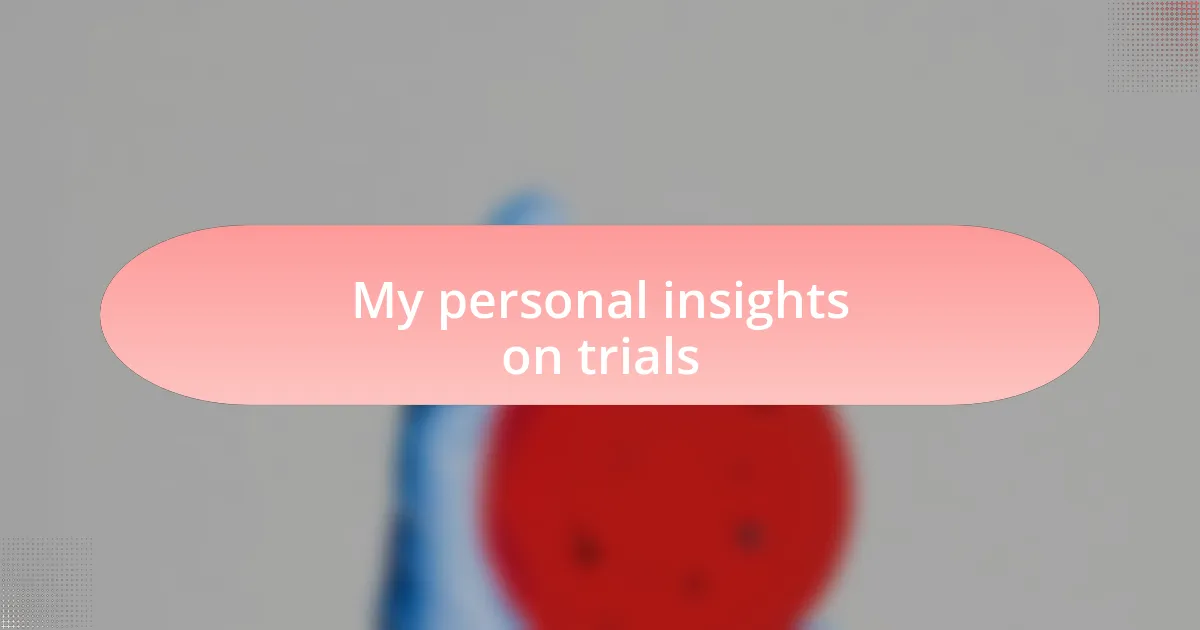
My personal insights on trials
When I reflect on the trial phases, one experience stands out vividly. I once spoke with a participant in a Phase I trial who described the anxiety that loomed over them, knowing they were among the first to receive a new treatment. It struck me how bravery intersects with scientific progress; each person involved bears a unique weight of responsibility that I find both inspiring and humbling.
Phase II reminds me of the excitement that comes with potential breakthroughs. I remember a discussion with a clinician deeply invested in a trial for a rare disease. The spark in their eyes while explaining how they modified a treatment based on patient feedback was palpable. I found myself wondering, how often do we witness the merging of hope and innovation into something tangible?
In Phase III, the stakes become even higher. I had the opportunity to attend a conference where researchers shared data from large-scale trials. The tension in the room was almost electric, as they discussed thousands of participants and the real-world impacts of their findings. It made me think: how many lives hang in the balance of every decision made during these phases? Each trial not only has the power to change medical practice but can also profoundly affect countless individuals.
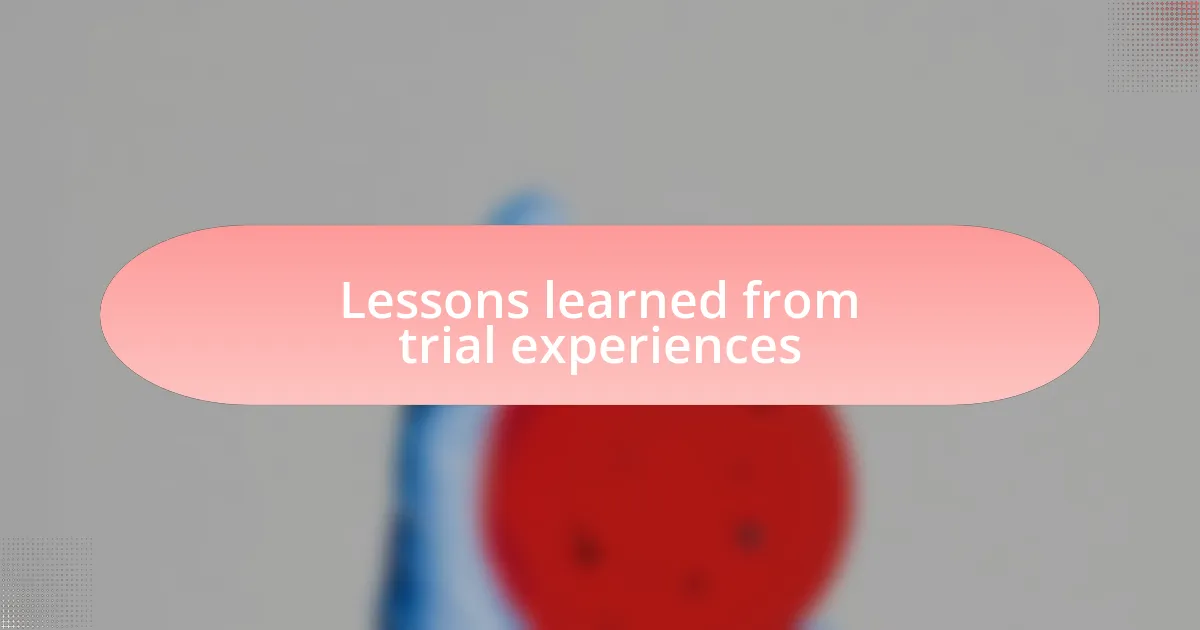
Lessons learned from trial experiences
The emotional landscape of trials is rich with lessons that often surprise me. During a recent seminar on trial outcomes, I sat next to a patient advocate who shared her heartbreak over a failed trial. She emphasized how important it is for researchers to communicate transparently about what went wrong. Reflecting on her experience led me to consider how communication can bridge the gap between scientific failure and patient understanding, transforming disappointment into a learning opportunity.
One lesson I’ve internalized from these experiences is the importance of adaptability. I remember attending a workshop where a researcher discussed how a last-minute protocol change based on preliminary results saved a trial from a potential setback. It hit me — success in trials isn’t solely about the initial hypothesis but also about the ability to pivot when faced with new data. How many breakthroughs come from unexpected directions?
I frequently think about the ethical dimensions of trials, especially after speaking with a bioethicist who described their role in safeguarding participant welfare. They noted that the greatest lessons often come from understanding the balance of risk and potential benefit. Are we prioritizing patient safety while still chasing innovation? This dialogue has shaped my view, reminding me that the soul of trial experiences lies not just in results, but also in the ethical integrity of the process.
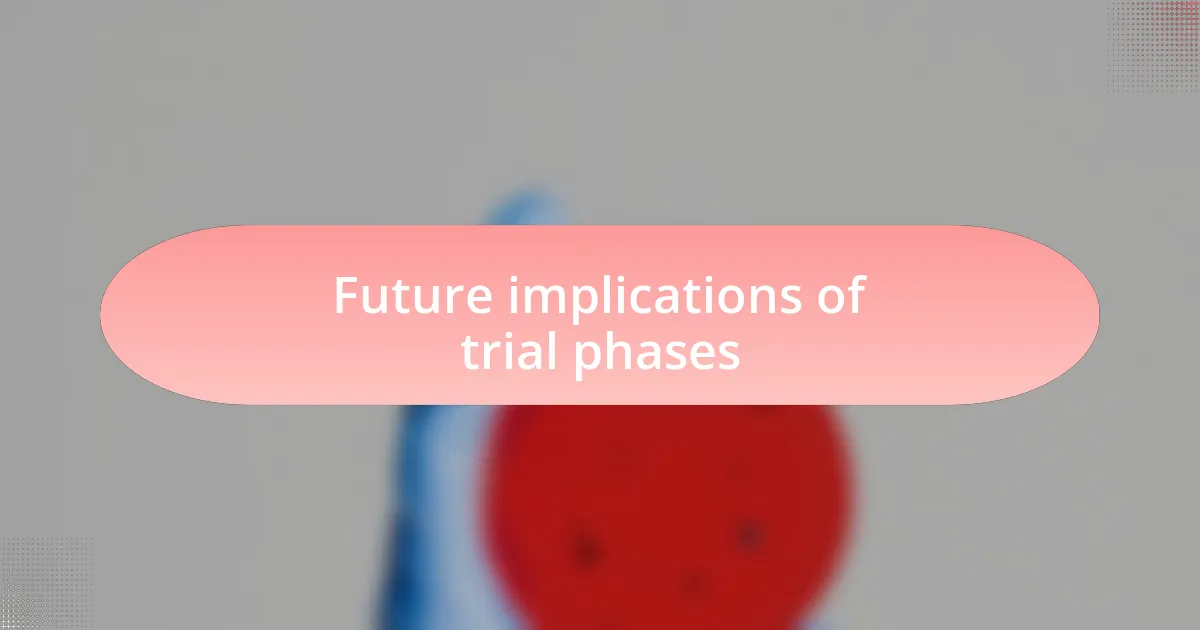
Future implications of trial phases
Considering the future implications of trial phases, I often find myself reflecting on how these experiences shape the landscape of medical research. For instance, I remember a conversation with a clinical researcher who anticipated that the data generated during earlier trial phases would guide the design of future studies. This evolution in how we approach trial design speaks volumes to my understanding of making more precise, informed decisions.
Moreover, I’ve seen how patient-centric methodologies are emerging from insights gained during trials. I recall attending a conference where a patient highlighted the side effects she had faced during trials that were not adequately addressed in previous research. The realization dawned on me: her voice could actually influence how trials are structured in the future. Isn’t it vital that we incorporate patient experiences to ensure trials are designed with their well-being in mind?
Looking ahead, I believe trial phases will increasingly focus on transparency. A fellow researcher shared how open data is reshaping the conversation around trial failures and successes. By making this information accessible, we invite more collaborative efforts within the research community. Will this shift encourage a more robust dialogue between researchers and patients, fostering trust and partnership? I genuinely hope it does, as it aligns with my belief that patient and researcher collaboration could usher in a new era of more effective, compassionate research practices.